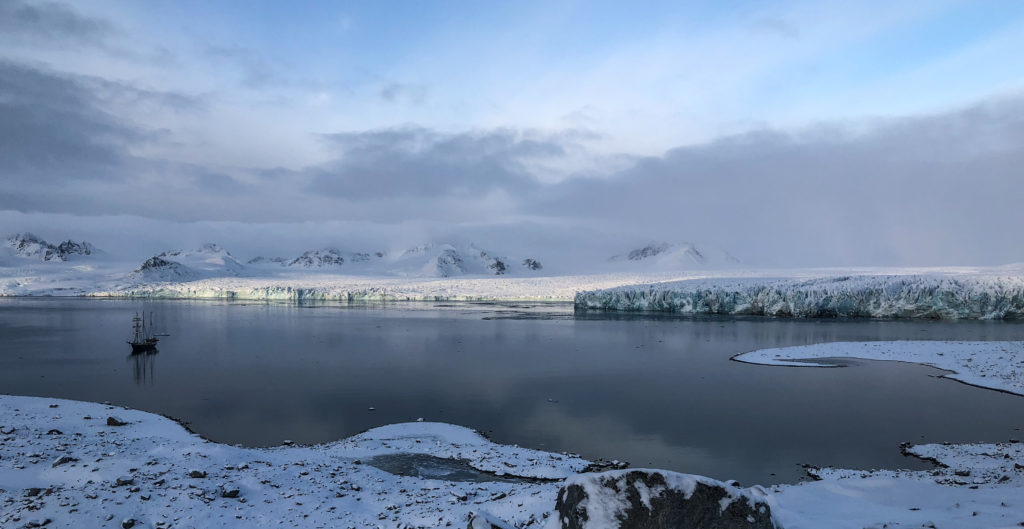
This is a drill.
One early autumn afternoon, toward the end of The Arctic Circle residency, many of the residents and crew were on deck pulling down the sails from our morning sailing, enjoying the sun and the views, painting, and chatting. The lead guide, Sarah, came out of the crew quarters, walked directly across the deck to the gunwale gate, opened it, and stepped off the side of the ship. On a day that probably had not risen above freezing, she jumped into the Arctic Ocean. I saw this happen. She was purposeful and composed. And, I thought, “Why did she do that?”
She was entirely encased in a red survival suit and wearing a life vest. Her face, with rosy cheeks and a few wildly curly locks of hair, was framed in red. John, standing next to me, yelled, “Man overboard” and pointed to her in the water, as we were instructed to do at some distant time in the past.
Everyone on deck scrambled, the Zodiac was lifted and launched, the second mate and another guide jumped in and off they went. By now, only a minute or two later, Sarah had drifted a substantial distance from the ship. The ship turned hard to when the alarm went up but the currents and the wind took her away. I watched with my binoculars. John held his position, not looking away from Sarah’s. She bobbed in the waves, floating easily, and just as easily disappearing into the swells and into the low-angled sunlight. As John later pointed out, it was probably the most peaceful eight minutes of her entire trip with us.

The Zodiac reached her, and the two women began maneuvering her deadweight into the boat. It took a couple of attempts to gain a solid hold (and why don’t survival suits have handles built in?) before they were able to slide her over the Zodiac’s tubing and onto the floor. They returned to the ship and lifted her out. A drill that required eight minutes, start to finish.

In the Arctic Ocean, two minutes means near certain death. For a ship underway, in heavy seas or the Arctic dark, two minutes is an impossibility. For a crew new to each other, under reasonably controlled circumstances, eight minutes was a good trial.
This is not a drill.
The climate change alarm went off long ago. The global survival suit, a tremendously thin layer of atmosphere between Earth and the universal void, has a few leaks. We’ve long known this. S
While many people stand around pointing, a handful more are scrambling to reduce emissions, decrease resource extraction, and increase a range of efficiencies. We can’t turn the whole planet hard to, or launch a Zodiac to drag floating carbon back to Earth.

I repeat this is not a drill.
Whether or not you believe in climate change, whether the climate change I believe in is caused by human-made CO2 or fluctuations in solar radiation, it is hard to deny that Earth is changing. Storm seasons are shifting, intensity, duration, and total numbers increasing. Droughts and floods are deepening, fire seasons extending, desertification encroaching. Glaciers are melting and pack ice is not forming. Animal ranges are expanding and contracting to retreat from or fill in newly (in)hospitable territory. Some creatures are disappearing entirely; waters are too warm, too acidic, too stagnant. Parasites and diseases previously kept in check by heat/cold/ water/drought are rampaging through populations that were once better able to withstand a seasonal, rather than a year-round, onslaught.
In reality, it doesn’t matter what we believe. The Earth is in rapid motion in uncharted territory.
My recommendation is, get the crew together and run a few emergency drills. We need the practice.


Your article presents both a human and scientific side of our social and global issues. The concept of preparatory drills applied to all facets reminds me to ask questions within my own surrounds. Where is my life boat? Who are my teammates? What protection do I need to keep ready and in good shape? With appreciation for this well-written piece of photo journalism.
Thank you, Elin. I’m glad you enjoyed it. It seems clear we need to shift focus – stop trying to prove what is or is not changing and start preparing for what we see coming. Like any community preparing for a blizzard or a hurricane, collectively, we need to take the long view and start stocking up.
Thanks, Tamara. Interesting and thought provoking. The pictures left me adrift in thought as much as the story. I can’t help but be sad for the losses ahead but feel a strong resolve to fight for our future the best ways I can. I must go now as it’s time to take the recycling out, take a long walk and drink sustainable fair trade coffee.
Don’t forget your cup!
Tamara,
Just now finding your website. Did you get the photos of you from our Arctic trip that I sent?
Your story and connections are profound
Thank you, Barbara. 🙂